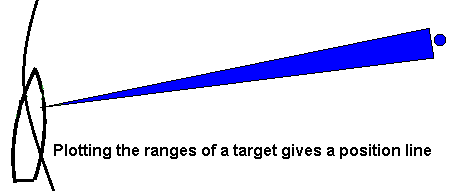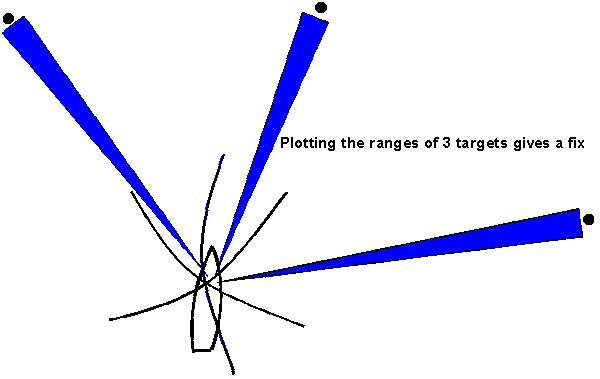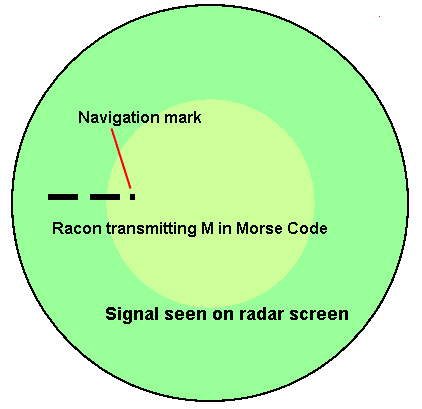Navigation and Chart work - The use of radar for navigation
Most motor vessels have radar and many sailing yachts have also fitted the equipment as it has become cheaper, less power hungry and more effective.
If you fit radar to your vessel you should consider taking an RYA radar course to make the most of your purchase, a day's training with an experienced tutor will enable you to get far more use out of the equipment.
Obviously most people fit radar to help identify other traffic in poor visibility but properly use it can be a major aid to navigation.
 Radar is very good at finding the range of a target but not so good at finding its bearing. This is because the beam sent out from the radar antenna has a width of a few degrees, this means that it can be difficult to identify the exact bearing of a target.
Radar is very good at finding the range of a target but not so good at finding its bearing. This is because the beam sent out from the radar antenna has a width of a few degrees, this means that it can be difficult to identify the exact bearing of a target.
Because of this, it may be difficult to identify the entrance to a harbour if it is narrow, or to differentiate between two navigation marks that are close together.
Getting a fix from radar
The best use of radar in navigation is to use its accuracy at detecting  the range of an object to give us a position circle. If we know the range of a charted object we can draw an arc at that distance from that object to give us a position line. As with any position line, we need to cross it with other position lines to get an accurate fix. If the ranges to three targets are measured three curved position lines can be plotted to give a fix.
the range of an object to give us a position circle. If we know the range of a charted object we can draw an arc at that distance from that object to give us a position line. As with any position line, we need to cross it with other position lines to get an accurate fix. If the ranges to three targets are measured three curved position lines can be plotted to give a fix.
If the range of the coastline is being measured, care should be taken to note what the radar is likely to be detecting. If the coast is low lying with high ground inland, the radar may be returning an echo from inland hills rather than the coast.
Racons
A Racon is a radar transponder device that transmits its own signal when  it receives a radar pulse. This signal in a distinctive letter in the Morse Code. This morse signal is displayed on the radar screen of the vessel sending our the initial radar pulse.
it receives a radar pulse. This signal in a distinctive letter in the Morse Code. This morse signal is displayed on the radar screen of the vessel sending our the initial radar pulse.
This pulse makes the target stand out from the background so it is only used on important navigation targets like major lights or the buoys that mark the ends of traffic separation schemes. Because the Morse signal could obscure the echo of the target the racon only operates part of the time, this gives the effect of the Morse signal appearing every few seconds rather than displaying continuously. To an inexperienced operator this may look like a very large vessel or just background clutter.
 The chart symbol for a racon is a magenta circle with Racon written next to it, normally the Morse Code letter that the racon transmits is included. Letters that consist of mainly dashes tend to be used as ones made up of only dots could be confused with other targets on the screen more easily.
The chart symbol for a racon is a magenta circle with Racon written next to it, normally the Morse Code letter that the racon transmits is included. Letters that consist of mainly dashes tend to be used as ones made up of only dots could be confused with other targets on the screen more easily.
New, temporary and uncharted hazards are often marked by a buoy with a racon that transmits the letter "D" in the morse code, dash dot dot (-..)
As with all navigation techniques, using the radar to fix your position from the range of charted objects must be practiced in easy conditions before you rely on it at night or in poor visibility.
1) Plot the following radar fix on Chart 3.
South Head - Range = 8.0M (46° 06.60'N 005° 49.66'W)
Cape Balshaw - Range = 9.2M (46° 08.80'N 006° 01.96'W)
Cook Point - Range = 11.3M (46° 00.23'N 006° 12.85'W)
What is the Latitude and Longitude of the vessel?
Save money by ordering your radar online.
Additional Resources:

